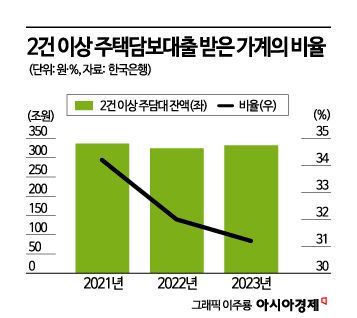The proportion of households that received two or more housing loans in the past 3 years is 32.5%.

.
,
, ‘It has been revealed that the proportion of households that have taken out two or more new housing collateral loans over the past 3 years amounts to 32%. There are concerns that government should establish regulations on loans taken for speculative purposes as household loans are increasing rapidly, especially among high-income groups.’,
,
, ‘According to data submitted by the Bank of Korea to the National Assembly’s Planning and Finance Committee on the 14th, the proportion of households that have taken out two or more housing collateral loans from 2021 to 2023 averaged 32.5%.’,
,
, ‘By year, the figures are 34.2% in 2021, 32% in 2022, and 31.2% in 2023. Estimating loan amounts based on the total housing collateral loan balance, it is 336.6 trillion won in 2021, 324.2 trillion won in 2022, and 332 trillion won in 2023.’,
,
, ‘When looking at total household loans and housing collateral loans by income quintile, it was found that high-income groups, the top 20%, dominated the borrowers. As of last year, the top 20% accounted for 78.1% of household debt and 93.7% of housing collateral loans.’,
,
, ‘Representative Cha Gyu-geun from the People Power Party of the National Assembly’s Planning and Finance Committee said, “Household loans and housing collateral loans are concentrated among high-income groups,” explaining that “those who have taken out two or more housing collateral loans among them account for 32%.” He emphasized that “the government should formulate measures to prevent financial inequality from leading to asset inequality.”‘,
,
,

Changyong Rhee, Governor of the Bank of Korea, is attending the Bank of Korea’s inspection by the National Assembly’s Planning and Finance Committee at the Bank of Korea in Jung-gu, Seoul on the 14th. Photo=Reporter Kang Jin-hyung aymstream@,
,
, ‘Total household loans, including housing collateral loans, are also on a significant rise, focusing on high-income and high-credit borrowers. They have been leading the recent increase in household loans and are considered a major factor in the rise in household debt.’,
,
, ‘According to data submitted by the Bank of Korea to Representative Park Sung-hoon of the People Power Party, as of the end of the first half of this year, the balance of household loans for high-credit borrowers with a credit score of 840 or higher reached 1458.9 trillion won. This is significantly higher compared to the balances of medium-credit borrowers (credit score 665-839) at 330.9 trillion won and low-credit borrowers (664 points or lower) at 69.5 trillion won.’,
,
, ‘Households with good credit scores witnessed a steep rise in their household loan balances. The balance of household loans for high-credit borrowers increased from 1165.5 trillion won at the end of the first half of 2019 to 1458.9 trillion won at the end of the first half of this year, marking a 25.2% growth.’,
,
, ‘In contrast, the balance of household loans for medium-credit borrowers decreased from 356.6 trillion won to 330.9 trillion won, a 7.2% decline, during the same period. The balance of household loans for low-credit borrowers also dropped from 87.1 trillion won to 69.5 trillion won, a 20.2% decrease. The average household loan balance per person as of the end of the first half of this year was significantly different for high-credit borrowers at 11.08 million won, medium-credit borrowers at 6.749 million won, and low-credit borrowers at 4.204 million won.’,
,
, ‘In terms of age groups, the increase in household loans was mainly led by the younger generation in their 30s and 40s. As of the end of the first half of this year, the balance of household loans by age group was highest for those in their 40s at 536.2 trillion won, followed by those under 30s at 496.3 trillion won, those in their 50s at 457 trillion won, and those aged 60 and above at 369.7 trillion won.’,
,
, ‘Compared to five years ago, the increase in household loan balances was most significant for those under 30, reaching 98.9 trillion won. This was followed by those aged 60 and above at 84.2 trillion won, those in their 40s at 64.8 trillion won, while those in their 50s saw an increase of 11 trillion won.’,
,

